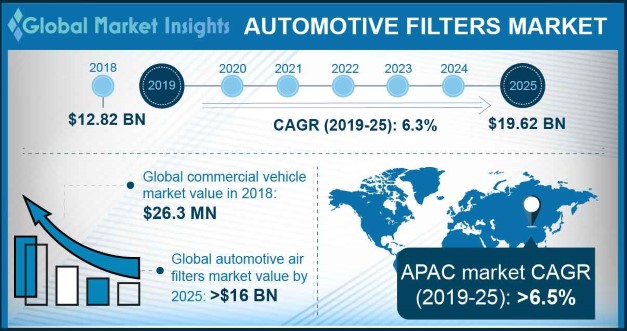Home > Automotive > Automotive Parts > Filters and Fluids > Automotive Filters Market
Automotive Filters Market Size
- Report ID: GMI497
- Published Date: Oct 2019
- Report Format: PDF
Automotive Filters Market Size
Automotive Filters Market size surpassed USD 12.82 billion in 2018 and is poised to grow at around 6.3% CAGR from 2019 to 2025.
Automotive filters are designed to help the engine of a vehicle to operate in a smooth manner, for improving the efficiency and reduction of maintenance cost of the vehicle. Filters are used in vehicles for oil purity, fuel purity, air purity, and emission exhaust purity. Their key purpose is to eradicate harmful particulates including dust and metal particles which results in vehicle performance deterioration.
Automotive filters maximize flow of clean air in order to minimize engine damage as it requires continuous supply of fresh air for its smooth operations and enhanced life span. High gasoline prices are expected to shift manufacturers focus on reduced fuel consumption. All modern vehicles including light & heavy commercial vehicles, two wheelers, and passenger cars are equipped with different filters for upgradation of power and vehicle efficiency.
| Report Attribute | Details |
|---|---|
| Base Year: | 2018 |
| Automotive Filters Market Size in 2018: | USD 12.82 Billion |
| Forecast Period: | 2019 to 2025 |
| Forecast Period 2019 to 2025 CAGR: | 6.3% |
| 2025 Value Projection: | USD 19.62 Billion |
| Historical Data for: | 2014 to 2018 |
| No. of Pages: | 285 |
| Tables, Charts & Figures: | 360 |
| Segments covered: | Product, Application, End-use, Region |
| Growth Drivers: |
|
| Pitfalls & Challenges: |
|
Shift in consumer preference towards diesel cars for fuel efficiency and necessity to reduce pollutants emission level is the major factor shaping industry dynamics. The automotive filters market growth is attributed to implementation stringent vehicle emissions regulations for reducing GHG emissions. Increased diesel passenger cars and commercial vehicles usage across the globe may lead to high pollution level. Henceforth, automobile manufacturers are investing in new product development to meet technical requirements of the upgraded emission norms.

